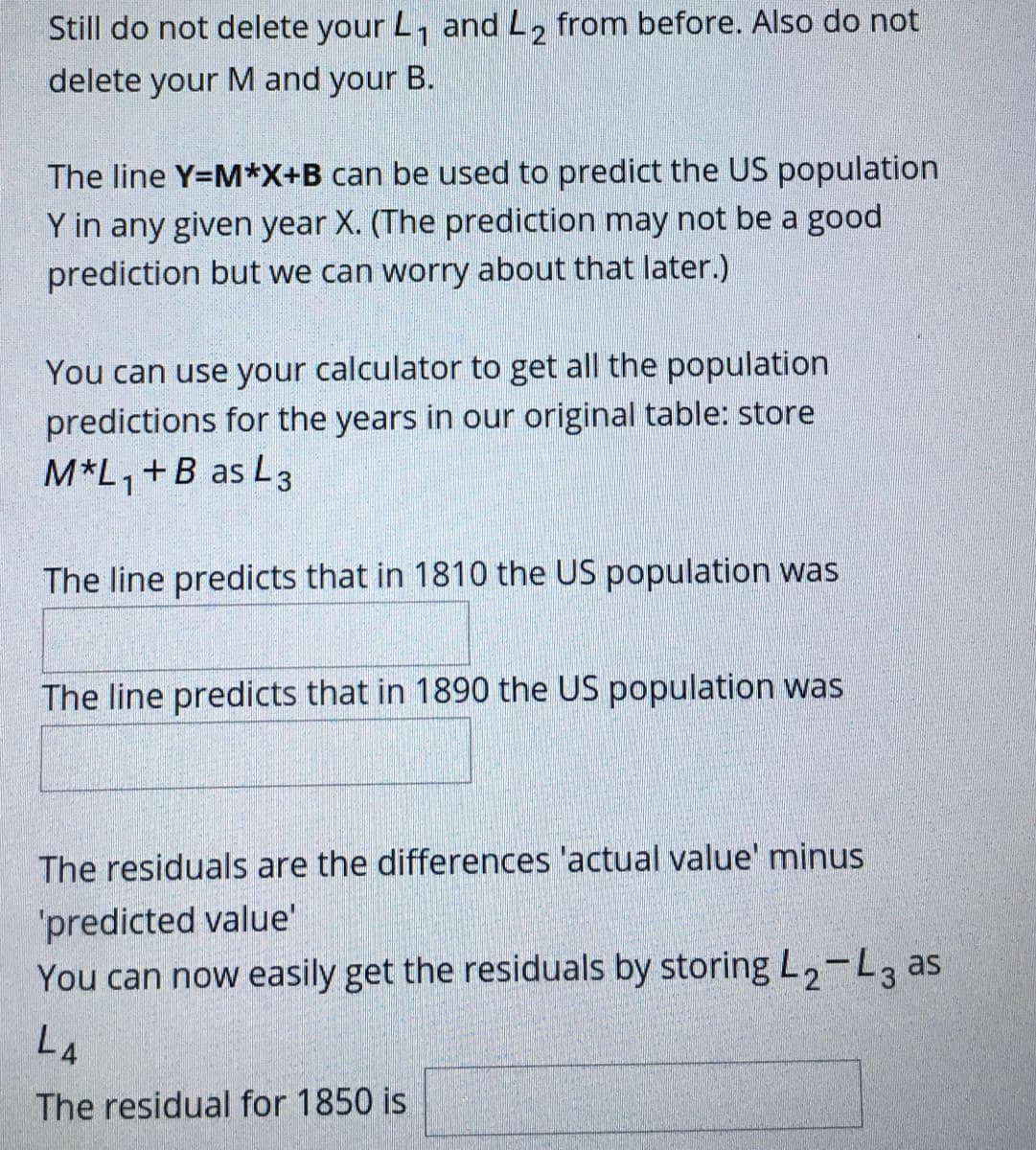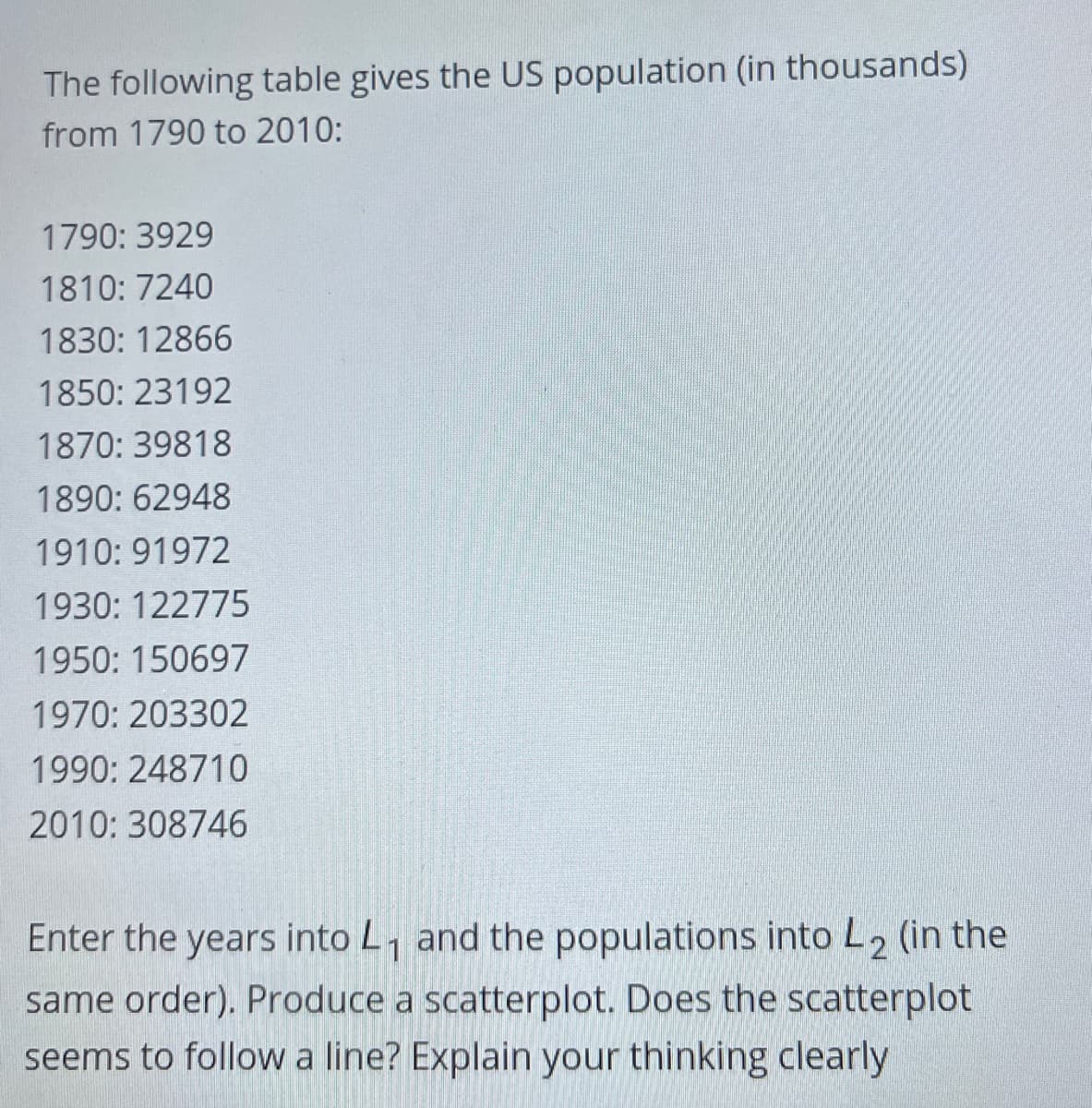Still do not delete your L, and L, from before. Also do not delete your M and your B. The line Y=M*X+B can be used to predict the US population Y in any given year X. (The prediction may not be a good prediction but we can worry about that later.) You can use your calculator to get all the population predictions for the years in our original table: store M*L,+B as L3 The line predicts that in 1810 the US population was The line predicts that in 1890 the US population was The residuals are the differences 'actual value' minus 'predicted value' You can now easily get the residuals by storing L,-L3 as L4 The residual for 1850 is
Still do not delete your L, and L, from before. Also do not delete your M and your B. The line Y=M*X+B can be used to predict the US population Y in any given year X. (The prediction may not be a good prediction but we can worry about that later.) You can use your calculator to get all the population predictions for the years in our original table: store M*L,+B as L3 The line predicts that in 1810 the US population was The line predicts that in 1890 the US population was The residuals are the differences 'actual value' minus 'predicted value' You can now easily get the residuals by storing L,-L3 as L4 The residual for 1850 is
Algebra & Trigonometry with Analytic Geometry
13th Edition
ISBN:9781133382119
Author:Swokowski
Publisher:Swokowski
Chapter10: Sequences, Series, And Probability
Section10.2: Arithmetic Sequences
Problem 68E
Related questions
Topic Video
Question
Solve the 2 questions please

Transcribed Image Text:Still do not delete your L, and L, from before. Also do not
delete your M and your B.
The line Y=M*X+B can be used to predict the US population
Y in any given year X. (The prediction may not be a good
prediction but we can worry about that later.)
You can use your calculator to get all the population
predictions for the years in our original table: store
M*L,+B as L3
The line predicts that in 1810 the US population was
The line predicts that in 1890 the US population was
The residuals are the differences 'actual value' minus
'predicted value'
You can now easily get the residuals by storing L,-L3 as
L4
The residual for 1850 is

Transcribed Image Text:The following table gives the US population (in thousands)
from 1790 to 2010:
1790: 3929
1810: 7240
1830: 12866
1850: 23192
1870: 39818
1890: 62948
1910: 91972
1930: 122775
1950: 150697
1970: 203302
1990: 248710
2010: 308746
Enter the years into L, and the populations into L2 (in the
same order). Produce a scatterplot. Does the scatterplot
seems to follow a line? Explain your thinking clearly
Expert Solution
This question has been solved!
Explore an expertly crafted, step-by-step solution for a thorough understanding of key concepts.
Step by step
Solved in 3 steps with 3 images

Knowledge Booster
Learn more about
Need a deep-dive on the concept behind this application? Look no further. Learn more about this topic, algebra and related others by exploring similar questions and additional content below.Recommended textbooks for you

Algebra & Trigonometry with Analytic Geometry
Algebra
ISBN:
9781133382119
Author:
Swokowski
Publisher:
Cengage

Functions and Change: A Modeling Approach to Coll…
Algebra
ISBN:
9781337111348
Author:
Bruce Crauder, Benny Evans, Alan Noell
Publisher:
Cengage Learning

Algebra & Trigonometry with Analytic Geometry
Algebra
ISBN:
9781133382119
Author:
Swokowski
Publisher:
Cengage

Functions and Change: A Modeling Approach to Coll…
Algebra
ISBN:
9781337111348
Author:
Bruce Crauder, Benny Evans, Alan Noell
Publisher:
Cengage Learning